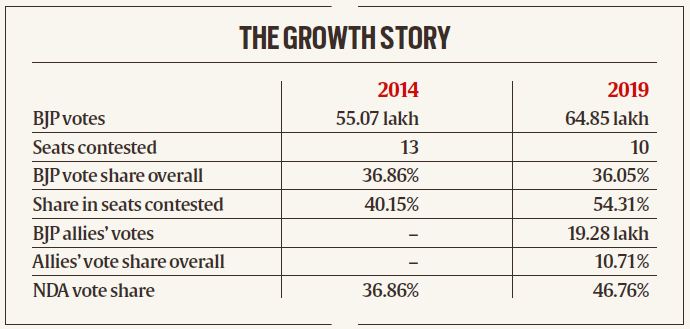Latest Comment
Post Comment
Read Comments
 Assam BJP workers celebrating their win at BJP Hegrabari office in Guwahati. (Express photo: Dasarath Deka)
Assam BJP workers celebrating their win at BJP Hegrabari office in Guwahati. (Express photo: Dasarath Deka)
In the Lok Sabha election results from Assam, where the BJP has improved from seven seats out of 14 in 2014 to nine seats in 2019, two questions might strike anyone who had followed the events in the state leading up to the election. How did the BJP gain when it had faced so much anger over the Citizenship (Amendment) Bill (CAB) being pushed by its government at the Centre? Second, when the BJP’s vote share in Assam has fallen fractionally from 36.86% in 2014 to 36.05% in 2019, how did that translate into two additional seats?
The first question should be addressed by demography. Assam minister Himanta Biswa Sarma said the CAB helped the BJP across the state by polarising voters. In areas where the Bill has enjoyed visible support, it does appear to have worked for the BJP. Even in areas where it has faced protests, the BJP made massive gains, but many factors are likely to have contributed to that.

The second question is answered by arithmetic. The BJP’s 36.86% vote share of 2014 was spread thinner, coming from 13 of the 14 seats, while the 36.05% this year comes from just the 10 seats that the BJP contested. If these state-wide vote shares are recalculated only for the seats actually contested, then the BJP polled 40.15% in 13 seats in 2014, and has improved hugely to 54.31% in 10 seats now.
The four seats that the BJP did not contest, in fact, were seen as its weak links. Its allies, AGP and Bodoland People’s Front, lost all four. If their vote shares are counted, the NDA share adds up to 46.76% in 14 seats.
Gains and losses
Of Assam’s two major geographical regions, the Barak Valley with two seats is predominantly Bengali, both Hindu and Muslim. The Brahmaputra Valley with 11 seats, which subdivides into Upper and Lower Assam, has a mixed demography that changes with geography, with the lowermost two seats, Dhubri and Barpeta, marked by a predominantly Muslim population, mostly of Bengali origin. In between the two regions is the 14th seat, a hill constituency formally called Autonomous District but popularly known as Diphu.
The BJP’s seven seats in 2014 had all been from among the 11 in the Brahmaputra Valley. This time, it has retained six of those and ceded one to the Congress (Nagaon), which it has compensated for by snatching Diphu from the Congress. What it has gained is the two seats of the Barak Valley, formerly held by the AIUDF and the Congress respectively.
Barak Valley
Opposition to the CAB has come primarily from within the Assamese-speaking community in the Brahmaputra Valley, across religious lines. It is in the Barak Valley that the CAB enjoys support, though it needs to be qualified. Bengali Hindus have largely welcomed the Bill, which seeks to ease Indian citizenship norms for Hindu migrants from Bangladesh (among other communities and nationalities), while Bengali Muslims in Barak Valley have opposed it.
Silchar in Barak Valley, which is predominantly Bengali Hindu, voted out sitting Congress MP Sushmita Dev. “The BJP has been determined to pass the Bill once it gets a majority in Rajya Sabha. Refugees who have come from Bangladesh and are settled in Assam want citizenship and the Bill will help them,” said BJP leader Kabindra Purkayastha, who had lost to Sushmita from Silchar in 2014.
Both Sushmita and her current BJP rival gained votes, but the numbers suggest that Sushmita ceded a significant section of her Bengali Hindu votes. In 2014, the AIUDF, which addresses Bengali Muslim voters, had polled over 10% in Silchar. Though the AIUDF was absent this time, the Congress share grew only from 42% to 44%, while the BJP share grew from 38% to over 52%.
The other Barak Valley seat, Karimganj, has a large Bengali Muslim population and is reserved for SCs. In a contest that eventually took shape between the BJP (45%) and the AIUDF (41%), the Congress (11%) is being seen as having taken part of the Muslim vote away from the AIUDF.
Brahmaputra Valley
The BJP may have dropped one seat in the Brahmaputra Valley, but its gains elsewhere in the region have been massive. Himanta cited the examples of Tezpur, where the BJP had won by 86,000 votes in 2014 and improved the margin to 2.4 lakh in 2019, and Lakhimpur, where the margin improved to 3.50 lakh, bettering even present CM Sarbananda Sonowal’s 2.9 lakh in 2014.
Asked if the CAB that contributed to these gains, Himanta said: “Once the Congress made it an issue against Hindu people, there will be polarisation.”
Other factors will have helped. Ahead of the elections, The Indian Express had published reports about voters being impressed with two of India’s longest river bridges in Upper Assam, besides schemes for tea tribes, a significant population. Also, the alliance with the AGP was aimed, in part, at giving the BJP acceptance among Assamese nationalist voters who might otherwise have voted against the CAB.
How then did the one seat slip away? Himanta said the result in Nagaon seat was “because of population”. While he refused to discuss demography (“We should not analyse who voted for us and who did not… Sabka Saath, Sabka Vikas, Sabka Viswas”), Nagaon district had a 55.36% Muslim population in 2011. The Lok Sabha constituency has nine Assembly segments and the BJP was ahead in six of these, but the other segments proved decisive. “In Jamunamukh and Laharighat, the difference was very big,” Himanta said. Jamunamukh alone gave the Congress a lead over 1 lakh; Nagaon was decided by less than 17,000 votes.



